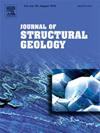从磷灰石(U-Th)/He年龄看甘孜-玉树(鲜水河)断层的新生代断裂及其对青藏高原东南部构造重组的影响
IF 2.6
2区 地球科学
Q2 GEOSCIENCES, MULTIDISCIPLINARY
引用次数: 0
摘要
位于川滇地壳碎片东北边界的甘孜-玉树-响水河断层为研究青藏高原东南部的构造演化和地球动力机制提供了机会。来自海拔横断面的磷灰石(U-Th)/He数据为甘孜-玉树断层的形成提供了有力的证据。下部样本一致的AHe年龄将断层活动的起始时间推定为9.4 ± 1.5 Ma。此外,锆石U-Pb年代测定和稀土元素(REE)分析证实雀儿山和高公花岗岩块体是作为一个整体隆起的,然后被甘孜-玉树断层移位。结合这两个岩体的总偏移量和断层活动的开始时间,可以得出甘孜-玉树断层的长期平均左侧走向滑动速率为 7.3-10.8 毫米/年。根据对青藏高原东南部同步变形的总结,包括整个甘孜-玉树-响水河断层活动的开始、红河断层的滑动逆转以及印支地块一系列左滑断层的活动,我们认为川滇地壳碎片的南向挤压和绕喜马拉雅东系的顺时针旋转开始于中新世中晚期(15-10Ma)。本文章由计算机程序翻译,如有差异,请以英文原文为准。
Cenozoic faulting of the Ganzi-Yushu (Xianshuihe) fault from apatite (U-Th)/He ages and its implications for the tectonic reorganization in the southeastern Tibetan plateau
The Ganzi-Yushu-Xianshuihe fault that lies along the northeastern boundary of the Chuan-Dian crustal fragment provides the opportunity to study the tectonic evolution and geodynamic mechanisms of the southeastern Tibetan Plateau. Apatite (U-Th)/He data from an elevation transect provide robust evidence for the initiation of the Ganzi-Yushu fault. The consistent AHe ages of the lower samples constrain the onset of fault activity to 9.4 ± 1.5 Ma. Moreover, the zircon U-Pb dating and rare earth element (REE) analysis confirm that the Queer Shan and Gaogong granitic plutons were emplaced as a whole and then displaced by the Ganzi-Yushu fault. Combining the total offset of these two plutons and the onset timing of the fault activity yields a long-term average left-lateral strike-slip rate of 7.3–10.8 mm/yr for the Ganzi-Yushu fault. Based on the summarized synchronous deformation in the southeastern Tibetan Plateau, including the initiation of fault activity along the whole Ganzi-Yushu-Xianshuihe fault, the slip reversal of the Red River fault, and the fault activity along a series of left-slip faults in the Indochina block, we suggest that the southward extrusion of the Chuan-Dian crustal fragment and clockwise rotation around the Eastern Himalayan Syntaxis initiated at the middle-late Miocene (15-10 Ma).
求助全文
通过发布文献求助,成功后即可免费获取论文全文。
去求助
来源期刊

Journal of Structural Geology
地学-地球科学综合
CiteScore
6.00
自引率
19.40%
发文量
192
审稿时长
15.7 weeks
期刊介绍:
The Journal of Structural Geology publishes process-oriented investigations about structural geology using appropriate combinations of analog and digital field data, seismic reflection data, satellite-derived data, geometric analysis, kinematic analysis, laboratory experiments, computer visualizations, and analogue or numerical modelling on all scales. Contributions are encouraged to draw perspectives from rheology, rock mechanics, geophysics,metamorphism, sedimentology, petroleum geology, economic geology, geodynamics, planetary geology, tectonics and neotectonics to provide a more powerful understanding of deformation processes and systems. Given the visual nature of the discipline, supplementary materials that portray the data and analysis in 3-D or quasi 3-D manners, including the use of videos, and/or graphical abstracts can significantly strengthen the impact of contributions.
 求助内容:
求助内容: 应助结果提醒方式:
应助结果提醒方式:


